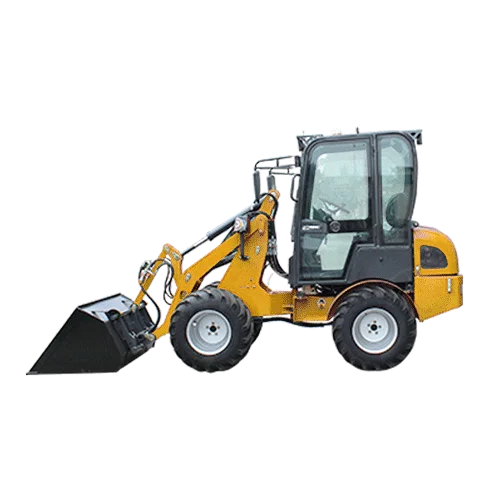Introduction

Loader tractors are pivotal in modern construction sites, transforming how tasks are completed with their exceptional versatility and power. Known for their ability to handle a variety of materials and perform numerous tasks, loader tractors are increasingly becoming indispensable in construction. This blog explores how loader tractors are revolutionizing construction sites, examining their benefits, applications, and the key factors driving their adoption in the industry.
What is a Loader Tractor?
A loader is a type of heavy machinery equipped with a front-mounted bucket or scoop. These machines are designed for lifting, carrying, and moving materials on construction sites. Key features of loader include:
- Front Loader Attachment: A bucket or scoop mounted on the front for material handling.
- Versatility: Capable of performing multiple tasks with various attachments.
- Power: Equipped with engines powerful enough to handle demanding tasks.
Benefits of Loader Tractors
Loader offer numerous benefits that make them a valuable asset on construction sites. Here’s a detailed look at the advantages:
Increased Efficiency
Loader tractors significantly enhance efficiency on construction sites by speeding up various tasks.
- Faster Material Handling: Quickly move and load materials, reducing manual labor.
- Time Savings: Perform multiple tasks in less time compared to traditional methods.
Versatility
The versatility of loader allows them to handle a wide range of tasks, making them a multi-functional tool on construction sites.
- Multiple Attachments: Can be fitted with various attachments such as forks, snow plows, and backhoes.
- Adaptability: Suitable for different tasks including digging, lifting, and grading.
Improved Productivity
By integrating loader into construction operations, productivity levels can be significantly increased.
- Higher Output: Efficient handling and movement of materials lead to increased overall productivity.
- Reduced Downtime: Minimize downtime with quick transitions between tasks.
Enhanced Safety
Loader tractors contribute to improved safety on construction sites by reducing the need for manual handling of heavy materials.
- Reduced Manual Labor: Decreases the risk of injuries associated with manual lifting and moving.
- Stable Operation: Provides a stable platform for handling heavy loads safely.
Cost-Effectiveness
Investing in loader can be cost-effective in the long run due to their efficiency and versatility.
- Lower Labor Costs: Reduces the need for manual labor and associated costs.
- Durability: Built to withstand harsh conditions, offering a good return on investment.
Precision and Control
Loaders provide precise control over material handling, enhancing the accuracy of tasks performed on-site.
- Accurate Placement: Allows for precise placement of materials, reducing waste and errors.
- Enhanced Maneuverability: Offers better control in tight spaces and challenging terrains.
Reduced Environmental Impact
Loader tractors contribute to a reduced environmental footprint through their efficient operation and fuel consumption.
- Fuel Efficiency: Designed to be more fuel-efficient compared to older machinery.
- Lower Emissions: Modern loader tractors have lower emissions, contributing to cleaner construction practices.
Applications of Loader Tractors
Loader tractors are used in a variety of applications on construction sites, demonstrating their versatility and functionality. Here’s a closer look at their common uses:
Excavation and Digging
Loaders are equipped to handle excavation tasks efficiently.
- Digging: Used for digging trenches and holes for foundations and utilities.
- Excavation: Capable of removing soil and debris from excavation sites.
Material Handling
Handling materials is a primary function of loader tractors on construction sites.
- Loading: Load materials such as gravel, sand, and dirt onto trucks or into bins.
- Transporting: Move materials from one location to another on-site.
Grading and Leveling
Grading and leveling tasks are simplified with loaders.
- Site Preparation: Prepare construction sites by leveling and grading surfaces.
- Surface Maintenance: Maintain roadways and other surfaces to ensure proper drainage and stability.
Snow Removal
In regions with snowfall, loaders can be adapted for snow removal tasks.
- Snow Plowing: Attachments for plowing snow from roads and pathways.
- Clearing: Remove snow and ice from construction sites and access roads.
Demolition Work
Loader tractors assist in demolition by removing debris and preparing sites for new construction.
- Debris Removal: Clear debris from demolished structures.
- Site Cleanup: Prepare sites for subsequent construction activities.
Landscaping
Loader tractors are useful in landscaping applications, providing efficient earth-moving capabilities.
- Soil Preparation: Prepare soil for planting and landscaping.
- Material Placement: Place and move landscaping materials such as mulch and rocks.
Construction Material Distribution
Distributing construction materials evenly across the site is a common application for loaders.
- Even Distribution: Spread materials like asphalt and gravel across large areas.
- Efficient Handling: Facilitate the even distribution of materials for construction purposes.
Practical Considerations

When integrating loader tractors into construction operations, consider the following practical aspects:
Maintenance and Care
Regular maintenance is essential to ensure the optimal performance and longevity of loaders.
- Routine Inspections: Regularly check fluid levels, tire conditions, and engine performance.
- Servicing: Follow manufacturer guidelines for scheduled servicing and repairs.
Operator Training
Proper training for operators is crucial for maximizing the benefits of loaders.
- Training Programs: Enroll operators in training programs to ensure they are proficient in using the machinery.
- Safety Practices: Emphasize safety practices to prevent accidents and ensure efficient operation.
Choosing the Right Model
Selecting the appropriate loader tractor model depends on specific construction needs and budget.
- Evaluate Requirements: Assess the tasks and materials the loader will handle.
- Budget Considerations: Choose a model that fits within your budget while meeting operational requirements.
Conclusion
Loader tractors are revolutionizing construction sites with their enhanced efficiency, versatility, and productivity. Their ability to handle various tasks, from excavation and material handling to snow removal and landscaping, makes them indispensable in modern construction. By understanding the benefits, applications, and practical considerations of loaders, construction professionals can make informed decisions and leverage this technology to improve their operations and achieve better results.
FAQ
What is a loader tractor?
A loader tractor is a type of heavy machinery equipped with a front-mounted bucket or scoop, designed for lifting, carrying, and moving materials on construction sites.
What are the main benefits of using loaders?
Benefits include increased efficiency, versatility, improved productivity, enhanced safety, cost-effectiveness, precision and control, and reduced environmental impact.
What tasks can loader tractors perform?
Loader tractors can perform tasks such as excavation, material handling, grading, snow removal, demolition work, landscaping, and construction material distribution.
How do I choose the right loader for my needs?
Consider factors such as engine power, bucket capacity, operating weight, lift height, load capacity, fuel tank capacity, and travel speed. Assess the specific tasks and materials the tractor will handle.
What are some common attachments for loader tractors?
Common attachments include front loaders, rotary tillers, post hole diggers, snow plows, mower decks, sprayers, seed drills, grader blades, and dump trailers.
How important is operator training for loaders?
Operator training is crucial for effective and safe use of loaders. Proper training helps maximize the benefits of the machinery and prevent accidents.
What maintenance is required for loader tractors?
Routine maintenance includes checking fluid levels, tire conditions, and engine performance. Follow manufacturer guidelines for scheduled servicing and repairs.

